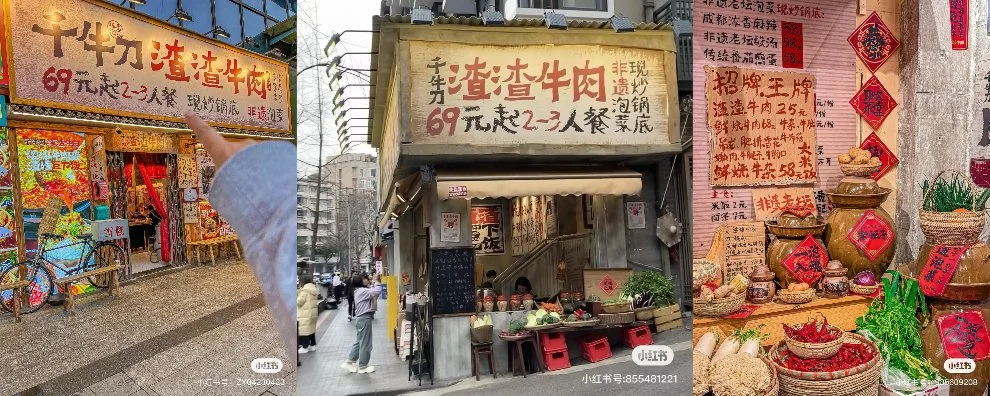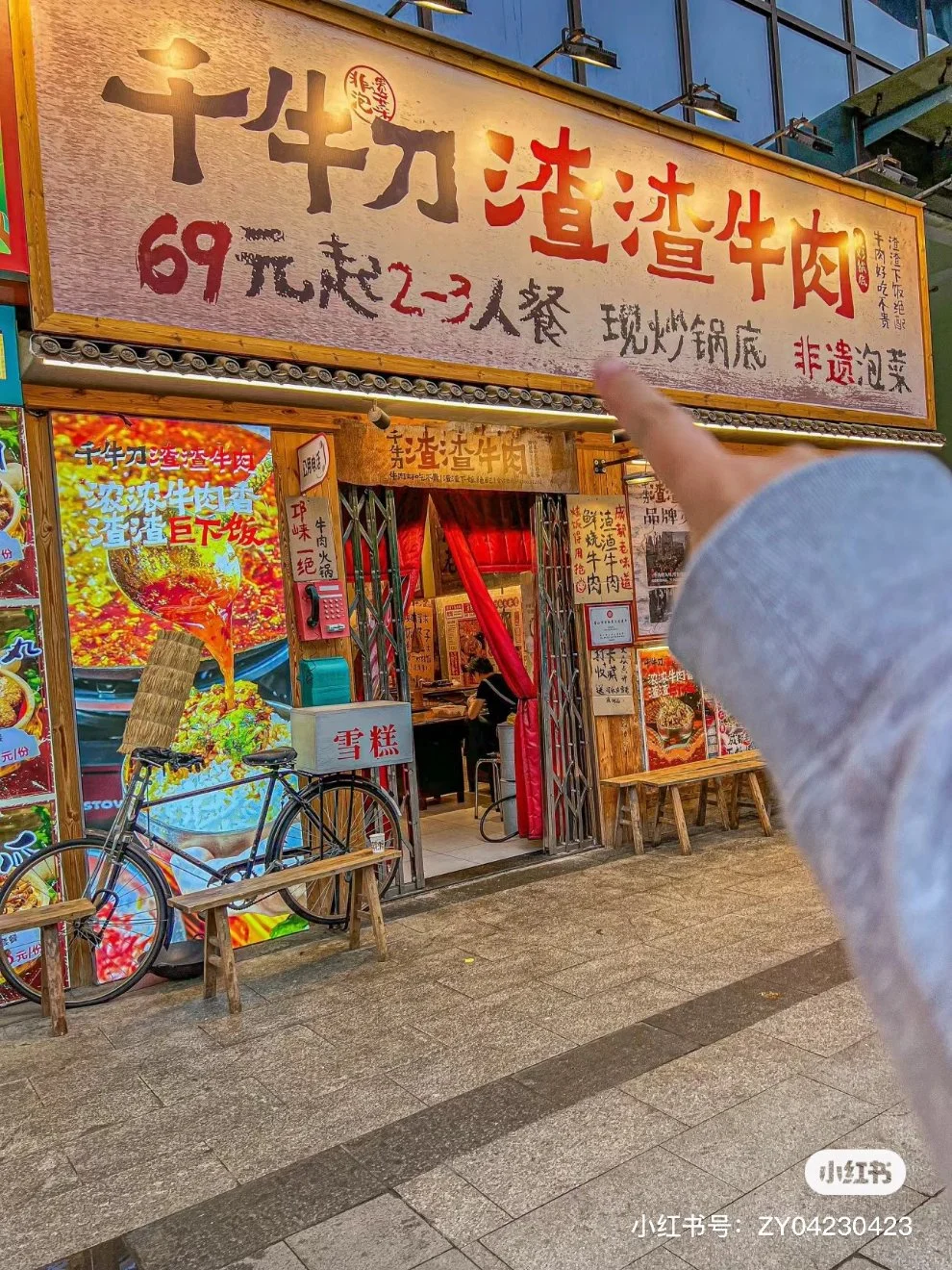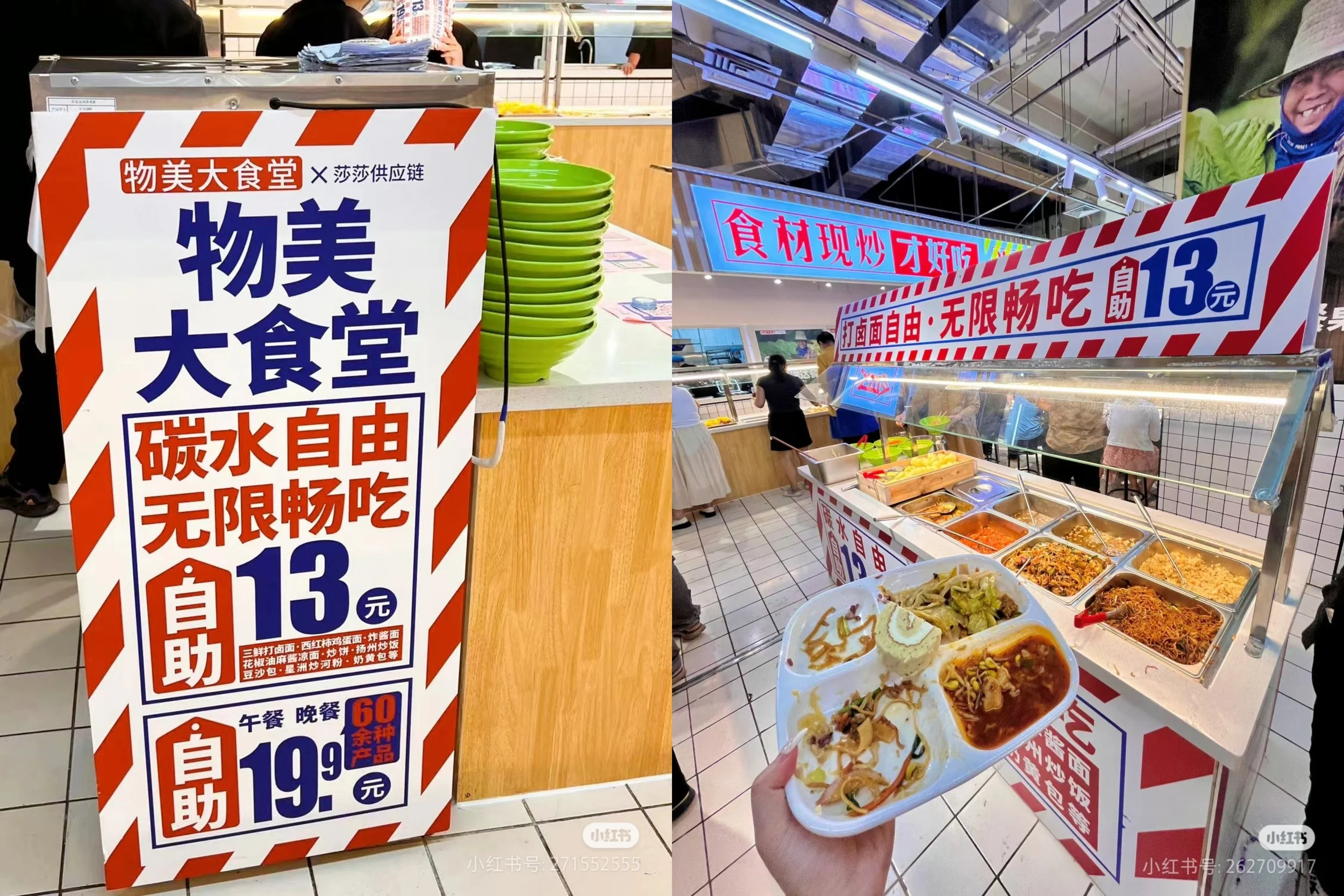Intensifying dining market competition: Storefronts as "price arenas"
Following the trends of ¥9.9 ($1.37) bakeries and ¥10 ($1.38) fast food restaurants, a new phenomenon has emerged in China's dining market. Restaurants are prominently displaying their prices on storefront signs to emphasize transparency and attract attention.
One of the most popular examples of this marketing strategy is a Beef Hotpot called “千牛刀渣渣牛肉“ from Chengdu, known for its eye-catching sign advertising a "¥69 ($9.52) meal for 2-3 people". This pricing strategy has proven effective in attracting customers during economic downturns. The restaurant's lively dining environment and menu have also appealed to consumers of all ages. It's reported that the turnover rate of tables in these restaurants reaches up to 20 times daily, and the brand has expanded to almost all provinces except Shanghai.

The storefront design and interior decoration style of the beef hotpot restaurant. Images are from RED.
Another example from Guangzhou, "YUSHEN Crispy Grilled Fish," also prominently displays its pricing starting “from ¥68 ($9.38)" on its storefront. Some netizens have pointed out that this kind of marketing is both aggressive and effective, accurately tapping into the sensitivity of today's consumers, making it hard to ignore.

The chain's grilled fish restaurants frequently emphasize the price of "68 RMB" in their décor.
Because this marketing approach is easy to replicate, more restaurants are adopting similar self-introductions like "Eat full for ¥30 ($4.14), eat well for ¥50 ($6.90)" or "Average spending per person not exceeding ¥30 ($4.14)." Some establishments even cater to introverted consumers by directly posting their menus on storefronts, ensuring that price concerns don't deter potential customers from entering. In summary, cost-effectiveness has become a primary consideration for many Chinese consumers. Many are willing to invest time comparing options repeatedly just to find lower-priced goods.

Most related cases involve primarily mid to low-end dining brands, where competition is extremely fierce.
A concise yet holistic summary of March 2025’s key marketing developments in China, highlighting valuable insights and their implications for brands.
Mixue has surpassed Starbucks and McDonald's to become the world's largest fast food chain. As the details illustrate, it wasn't by accident. The company's record-breaking IPO looks set to fund its next round of expansion
A concise yet holistic summary of February 2025’s key marketing developments in China, highlighting valuable insights and their implications for brands.
Xianyu has evolved from a second-hand marketplace into a hub for youth culture, side hustles, and digital innovation, offering valuable insights for foreign brands in China
Jack Ma launched New Retail with a roar in 2016 starting a scramble for the New Retail crown on both sides of the Pacific. The buzzword has since fizzled out and Alibaba has divested in much of its bricks & mortar retail properties, but the need to rethink retail is more important than ever. Here's why...
Chinese sanitary pad brands face backlash over misleading lengths and pH standards akin to tablecloths, sparking consumer boycotts and calls for reform. The willingness to talk about once-taboo products shows a new era of consumer pushback and could provide advantages for cross border products
China's seniors are one of the most anticipated demographics, yet one of the least tapped by foreign brands. Preferences, behaviour and influences are all changing, helping to make them more accessible for foreign brands
China's consumer landscape is increasingly divergent. Lower-tier cities are rebounding faster and showing greater resilience than first- and second-tier cities. While large catering businesses struggle, smaller restaurants thrive. How can brands understand these diverging trends and their implications? Read on to find out more.
Traditionally, yoghurt has been seen as a symbol of purity, health, and deliciousness. But what would happen if we blended it with the flavours of some famous regional Chinese cuisines?
A number of high-end restaurants in China have closed or cut prices to stay afloat in the fierce dining market. However, we're seeing restaurants that blend dining with immersive experiences dining popular among young consumers, without lowering prices. Even without supply chain or scale advantages, these places are gaining a distinct competitive edge.
With the Mid-Autumn Festival approaching, mooncakes—an essential traditional treat—are once again showcasing innovative and exciting variations. This round up of intriguing and unusual mooncakes may provide inspiration for product development beyond the traditional treat!
With the advancement of AI, many industries have successfully reduced costs and increased efficiency, and the food & beverage sector has seen the emergence of many innovative and data-driven products. However, are AI-developed foods really as good as we imagine yet?
As the “lying flat” lifestyle grows among Chinese workers looking to unwind, more urbanites are seeing the allure of cruises return. This stress-free approach to travel fits perfectly with the cruise experience, leading more Chinese to choose cruises as their ideal escape.
In April, Lin Yuanchun birch water became the top-selling beverage on Douyin, surpassing brands like Coca-Cola and Oriental Leaf. Birch water continues to gain popularity, driven by its health benefits and the aggressive marketing on social media.
Just like us, pets need to beat the heat during the sweltering summer months. From stylish cooling mats and pads, to ice collars and breezy apparel, a wave of functional and fashionable products has been heating up China's pet supplies market, creating promising seasonal opportunities.
Durian-related food and drinks are currently getting a lot of attention on Chinese social media. Here are some examples of how brands and restaurants are incorporating durian into their offerings
As Chinese Valentine's Day, Qixi Festival (七夕节) conveys Chinese-style unique romance between lovers and couples. Check it out to see how brands are embracing this traditional festival in creative ways.
Guizhou sour soup hotpot is captivating Chinese consumers’ taste buds this summer. It’s as visually appealing as it is unique, with a distinctive blend of both sour and spicy flavours. Check it out to find more about its recipe for success in China's competitive hotpot market.
As competition in the Chinese dining market intensifies once again, a number of low- and mid-range brands are directly writing their prices on their storefronts. Although this move is direct, the results have seen brands begin to imitate this set of marketing methods.
Traditional supermarket chains in China are struggling due to the intense competition from e-commerce. As consumer shopping and dining habits shift, these supermarkets are turning to in-store dining areas or large canteens to stay in business.
Once an old, obscure brand selling posture-correction brace, Babaca has achieved a successful comeback by leveraging celebrity and KOL marketing, but many people question it is a ‘IQ tax'.
This spring, many upscale dining brands have started offering breakfast options, aiming to attract more customers by expanding their business lines.
A bakery in Hangzhou drew many customers with its "9.9 Yuan" marketing slogan in May. Since then, numerous low-price bakeries have popped up across the country.
China big ecommerce festivals act as a barometer for consumer sentiment, but this year’s 618 also provides wider lessons into what is working with Chinese consumers right now
As oat milk’s popularity fades in China, rice milk appears to be the next cab to fill the plant-based gap, with the familiarity and versatility of rice milk being combined with big health claims
Chinese consumers’ facial cleansing products have seen better growth than the overall skincare market over the past year, but new bars providing the services face multiple challenges
Press-on nails are all the rage in China due to their distinct advantages over alternatives
Haidilao and Jiuyang are two hugely successful domestic brands in China’s competitive landscape, utilising mantras like “Go wherever people are going” and “Try whatever consumers are interested in.”
Brands such as Lululemon and Starbucks are incorporating the rising Chinese folk culture trend into their marketing, but interestingly, no one has yet tapped into the popularity of the Yingge Dancing
Changes in behaviour over the Chinese NY holiday show that foreign brands continue to hold a lot of appeal, even during the most traditional of holidays






























